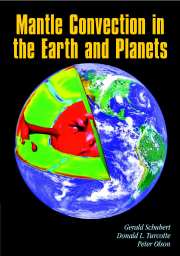Book contents
- Frontmatter
- Contents
- Preface
- 1 Historical Background
- 2 Plate Tectonics
- 3 Structure and Composition of the Mantle
- 4 Mantle Temperatures and Thermodynamic Properties
- 5 Viscosity of the Mantle
- 6 Basic Equations
- 7 Linear Stability
- 8 Approximate Solutions
- 9 Calculations of Convection in Two Dimensions
- 10 Numerical Models of Three-dimensional Convection
- 11 Hot Spots and Mantle Plumes
- 12 Chemical Geodynamics
- 13 Thermal History of the Earth
- 14 Convection in the Interiors of Solid Planets and Moons
- 15 Nature of Convection in the Mantle
- References
- Appendix: Table of Variables
- Author Index
- Subject Index
8 - Approximate Solutions
Published online by Cambridge University Press: 15 December 2009
- Frontmatter
- Contents
- Preface
- 1 Historical Background
- 2 Plate Tectonics
- 3 Structure and Composition of the Mantle
- 4 Mantle Temperatures and Thermodynamic Properties
- 5 Viscosity of the Mantle
- 6 Basic Equations
- 7 Linear Stability
- 8 Approximate Solutions
- 9 Calculations of Convection in Two Dimensions
- 10 Numerical Models of Three-dimensional Convection
- 11 Hot Spots and Mantle Plumes
- 12 Chemical Geodynamics
- 13 Thermal History of the Earth
- 14 Convection in the Interiors of Solid Planets and Moons
- 15 Nature of Convection in the Mantle
- References
- Appendix: Table of Variables
- Author Index
- Subject Index
Summary
Introduction
The linear stability analysis presented in the last chapter gives the critical Rayleigh number for the onset of thermal convection under a variety of conditions. However, because the governing equations have been linearized, the solutions cannot predict the magnitude of finite-amplitude convective flows. In order to do this it is necessary to retain nonlinear terms in the governing equations.
Even in the simplest thermal convection problems the governing equations are sufficiently complex that analytical solutions cannot be found. There are basically two methods for obtaining nonlinear solutions. The first is to make approximations and the second is to obtain fully numerical solutions. We will address the former method in this chapter and the latter method in the subsequent two chapters.
In this chapter we will consider four approximations used to obtain a better understanding of thermal convection. We first consider an eigenmode expansion of the basic equations. This approach provides one of the methods used to obtain fully numerical solutions. However, in this chapter we consider only severe truncations of the full set of eigenmode equations. Retention of only the lowest-order nonlinear terms leads to the Lorenz (1963) equations. This set of equations is of great interest because its solution was the first demonstration of deterministic chaos. In this approximate approach we address the question:
Question 8.1: Is mantle convection chaotic?
This questions leads directly to a second question:
Question 8.2: Is mantle convection turbulent?
The second approximate approach we consider is boundary layer theory. This approach reproduces the basic structure of thermal convection cells at high Rayleigh numbers. The third approach is the mean field approximation.
- Type
- Chapter
- Information
- Mantle Convection in the Earth and Planets , pp. 330 - 375Publisher: Cambridge University PressPrint publication year: 2001

